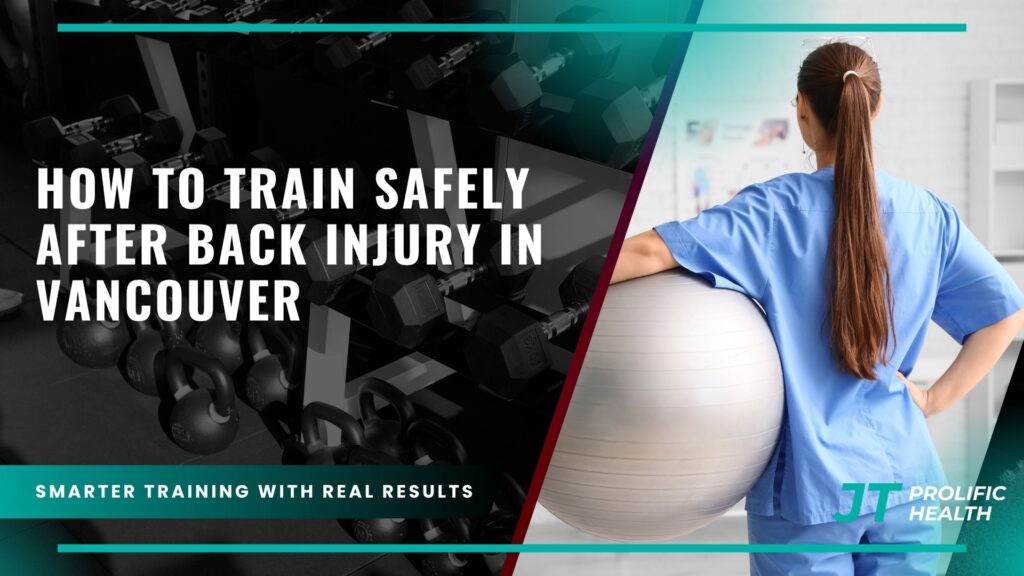Recovering from a back injury can feel like navigating uncharted territory, especially when you’re eager to return to your fitness routine. In Vancouver, where an active lifestyle is deeply ingrained in the culture, the challenge of safely resuming exercise after a back injury becomes even more pressing. Whether you’ve experienced a herniated disc, muscle strain, or any other back-related injury, the path back to full activity requires careful planning, professional guidance, and a thorough understanding of your body’s healing process.
The journey of back injury rehabilitation is rarely straightforward. Many people make the mistake of either rushing back too quickly, leading to re-injury, or becoming overly cautious and avoiding movement altogether, which can actually hinder recovery. The key lies in finding the right balance between appropriate rest and progressive movement that promotes healing while building strength and resilience.
Vancouver’s fitness community has increasingly recognized the importance of specialized approaches to post-injury training. The city’s personal trainers, physiotherapists, and fitness professionals have developed comprehensive protocols that address not just the physical aspects of recovery, but also the psychological barriers that often accompany back injuries. Fear of re-injury, loss of confidence, and anxiety about movement are common challenges that must be addressed alongside the physical rehabilitation process.
Understanding how to train safely after a back injury isn’t just about knowing which exercises to avoid – it’s about creating a systematic approach that rebuilds your foundation from the ground up. This involves addressing movement patterns, strengthening supporting muscle groups, improving flexibility and mobility, and gradually progressing toward your pre-injury activity levels. The process requires patience, consistency, and often professional guidance to ensure you’re making progress without compromising your recovery.
The unique aspects of living in Vancouver – from the city’s outdoor recreation opportunities to its wet climate that can affect joint stiffness – add additional considerations to the rehabilitation process. Local fitness professionals understand these environmental factors and can tailor recovery programs that account for seasonal variations and the specific activities that Vancouver residents love to pursue.
Key Takeaways
For additional context, see this comprehensive guide.
- Professional Assessment is Essential: Before beginning any exercise program after a back injury, obtain clearance from a healthcare provider and consider working with a qualified personal trainer who has experience in injury rehabilitation. This ensures your program is appropriate for your specific condition and recovery stage.
- Start with Movement Fundamentals: Focus on basic movement patterns like breathing, gentle stretching, and core activation before progressing to more complex exercises. These foundational movements help restore proper function and build confidence in your body’s ability to move safely.
- Progressive Loading is Key: Gradually increase the intensity, duration, and complexity of your exercises over time. This systematic approach allows your tissues to adapt and strengthen while minimizing the risk of re-injury.
- Core Stability Takes Priority: Developing a strong, stable core is crucial for protecting your back during exercise and daily activities. This includes not just the abdominal muscles, but also the deep stabilizing muscles of the spine and pelvis.
- Listen to Your Body: Learn to distinguish between normal exercise discomfort and pain that signals potential problems. Developing this body awareness is crucial for long-term success and injury prevention.
- Address Movement Quality: Focus on proper form and movement patterns rather than just strength or endurance. Poor movement quality can perpetuate dysfunction and increase injury risk, regardless of how strong you become.
- Include Mobility and Flexibility: Incorporate regular stretching and mobility work to address restrictions that may have developed during your injury or recovery period. This helps restore normal movement patterns and reduces compensation strategies.
- Plan for Setbacks: Recovery isn’t always linear, and minor setbacks are normal. Having strategies to manage flare-ups and knowing when to modify your program helps maintain long-term progress.
Understanding Back Injury Recovery in Vancouver’s Context

Vancouver’s unique environment and lifestyle present both opportunities and challenges for back injury recovery. The city’s commitment to outdoor recreation means that many residents are highly motivated to return to activities like hiking, cycling, skiing, and water sports. However, this same enthusiasm can sometimes lead to premature return to high-impact activities before the body is adequately prepared.
The Pacific Northwest climate also plays a role in recovery planning. The region’s frequent rain and cooler temperatures can affect joint stiffness and muscle tension, particularly during the fall and winter months. Many people with back injuries report increased stiffness during these periods, making it essential to adapt exercise routines accordingly. Indoor training becomes more important during these months, and having access to proper facilities and equipment is crucial for maintaining consistency in your rehabilitation program.
Vancouver’s healthcare system provides excellent resources for back injury recovery, with numerous physiotherapy clinics, sports medicine specialists, and rehabilitation centers throughout the city. However, the transition from clinical rehabilitation to independent fitness training often requires additional support. This is where qualified personal trainers who understand injury recovery become invaluable partners in your journey back to full activity.
The city’s fitness culture also emphasizes functional movement and holistic approaches to health, which align well with effective back injury rehabilitation principles. Many Vancouver fitness professionals have embraced evidence-based practices that prioritize movement quality, progressive loading, and individualized program design – all essential elements for safe post-injury training.
The Foundation: Medical Clearance and Professional Assessment


Before embarking on any exercise program following a back injury, obtaining proper medical clearance is non-negotiable. This step involves more than just getting a doctor’s approval to exercise – it requires a comprehensive understanding of your specific injury, any limitations or precautions you should observe, and the expected timeline for recovery. Your healthcare provider should provide clear guidelines about what activities are safe to begin with and what should be avoided during the initial phases of your return to exercise.
The assessment process should include a detailed discussion of your injury mechanism, symptoms, and any treatments you’ve received. Understanding whether your injury involved disc problems, muscle strains, ligament damage, or other structures helps determine the most appropriate exercise approach. Different types of back injuries require different recovery strategies, and what works for one person may not be suitable for another.
Once you have medical clearance, the next crucial step is working with a qualified fitness professional who has experience in post-injury training. When evaluating potential trainers for your recovery journey, look for those with relevant certifications in corrective exercise, injury rehabilitation, or similar specializations. These professionals can conduct a thorough movement assessment to identify any compensations, weaknesses, or restrictions that need to be addressed in your program.
A comprehensive movement assessment typically includes evaluation of your posture, basic movement patterns like squatting and bending, core stability, and flexibility. This assessment helps identify not just the obvious limitations related to your injury, but also secondary issues that may have developed as a result of altered movement patterns during your recovery period. For example, favoring one side to avoid pain can lead to imbalances that need to be corrected to prevent future problems.
The professional assessment should also consider your specific goals and lifestyle factors. Are you hoping to return to competitive sports, or is your primary concern being able to play with your children without pain? Do you have a physically demanding job that requires specific movement patterns? Understanding these factors helps create a more targeted and relevant rehabilitation program that addresses your real-world needs rather than following a generic protocol.
Building Your Foundation: Core Stability and Movement Patterns


The cornerstone of safe training after a back injury lies in rebuilding fundamental movement patterns and establishing proper core stability. Many people misunderstand core training, thinking it’s primarily about achieving visible abdominal muscles or performing challenging exercises like planks. In reality, effective core training for back injury recovery focuses on the deep stabilizing muscles that provide support and control for the spine during movement.
The process begins with learning proper breathing techniques and basic core activation. Diaphragmatic breathing not only helps with relaxation and pain management but also plays a crucial role in core stability. The diaphragm works in coordination with the pelvic floor muscles and deep abdominal muscles to create internal pressure that supports the spine. Learning to breathe properly while maintaining this gentle core activation forms the foundation for all subsequent exercises.
Basic movement patterns should be reintroduced systematically, starting with simple activities like rolling, sitting to standing, and walking. These movements might seem too basic, but they’re essential for reestablishing proper coordination and confidence in your body’s ability to move safely. Each movement should be performed with attention to proper alignment and core engagement, creating positive movement experiences that help overcome fear and hesitation.
As these fundamental patterns improve, you can progress to more challenging movements like squatting, lunging, and reaching activities. The key is maintaining perfect form and control throughout each exercise, even if this means using very light weights or no external resistance at all. Developing proper movement skills takes time and repetition, but this investment pays dividends in terms of long-term success and injury prevention.
Flexibility and mobility work should be integrated throughout this process, addressing any restrictions that limit normal movement patterns. Common areas that require attention after back injuries include hip flexibility, thoracic spine mobility, and hamstring length. However, stretching should be approached carefully, avoiding aggressive stretching that might irritate healing tissues. Gentle, sustained stretches and mobility exercises are typically more appropriate during the early stages of recovery.
Progressive Exercise Programming and Load Management
Once you’ve established a solid foundation of movement quality and core stability, the next phase involves systematically progressing your exercise program to build strength, endurance, and resilience. This progression must be carefully managed to provide enough stimulus for adaptation while avoiding overload that could lead to setbacks. The principle of progressive overload applies to injury recovery, but it requires a more conservative and methodical approach than typical fitness training.
The progression typically follows a logical sequence from bodyweight exercises to light resistance training, then gradually increasing load, complexity, and training volume. Early exercises might include wall sits, modified planks, gentle bridges, and assisted squats. These exercises allow you to work on strength and endurance while maintaining perfect control and form. The emphasis should always be on quality over quantity – performing fewer repetitions with perfect form is far more valuable than pushing through fatigue with compromised technique.
Resistance training can be introduced using various tools, depending on your comfort level and access to equipment. Resistance bands are often ideal for early-stage training because they provide variable resistance and are less intimidating than weights. As you progress, light dumbbells, kettlebells, and eventually barbells can be incorporated. The key is starting with loads that feel almost too easy and progressing gradually based on how your body responds.
Cardiovascular exercise also plays an important role in recovery, but the choice of activities requires careful consideration. Low-impact options like walking, swimming, or stationary cycling are typically safer choices during early recovery. High-impact activities like running or jumping should be introduced much later in the process and only after you’ve demonstrated good tolerance for other forms of exercise. The lifestyle modifications that support recovery often include incorporating more walking and gentle movement throughout the day.
Monitoring your response to exercise is crucial during this phase. This includes tracking not just how you feel during workouts, but also how you feel in the hours and days following exercise. Some delayed soreness is normal, but increased back pain, stiffness, or other symptoms might indicate that you’re progressing too quickly or that certain exercises aren’t appropriate for your current stage of recovery. Learning to interpret these signals and adjust your program accordingly is a valuable skill that will serve you well throughout your fitness journey.
Addressing Psychological Factors and Building Confidence
The psychological aspects of recovering from a back injury are often underestimated but play a crucial role in successful rehabilitation. Fear of re-injury, loss of confidence in your body’s capabilities, and anxiety about movement can create significant barriers to recovery. These psychological factors can actually perpetuate physical symptoms and limit your willingness to engage in the activities necessary for full recovery.
Fear avoidance behavior is particularly common after back injuries. This involves avoiding certain movements or activities because of concern about causing pain or further damage. While some caution is appropriate during early recovery, excessive fear avoidance can lead to deconditioning, increased stiffness, and prolonged disability. The key is learning to distinguish between appropriate caution and counterproductive fear.
Building confidence requires a systematic approach that provides positive movement experiences while gradually challenging your comfort zone. This is where working with an experienced professional becomes invaluable. Professional guidance can significantly boost your confidence by providing expert supervision, appropriate exercise modifications, and reassurance during challenging moments.
Education plays a crucial role in overcoming fear and building confidence. Understanding the nature of your injury, the healing process, and the rationale behind your exercise program helps reduce anxiety and increases your willingness to participate actively in recovery. Many people benefit from learning about pain science and understanding that some discomfort during exercise doesn’t necessarily indicate tissue damage.
Setting realistic goals and celebrating small victories helps maintain motivation and build momentum throughout the recovery process. Rather than focusing solely on returning to pre-injury activity levels, acknowledge improvements in daily function, reduced pain levels, increased exercise tolerance, and enhanced quality of life. These incremental improvements are often more meaningful than dramatic fitness achievements and provide sustainable motivation for long-term adherence to your program.
Social support also plays an important role in psychological recovery. This might involve family and friends, but can also include connecting with others who have experienced similar injuries or working with healthcare providers who understand the challenges you’re facing. The sense of community and shared experience can provide both practical advice and emotional support during difficult periods of your recovery.
Long-term Strategies and Injury Prevention
Successfully returning to exercise after a back injury is just the beginning of a lifelong commitment to maintaining back health and preventing future problems. The strategies that helped you recover should become permanent components of your fitness routine, not temporary measures that you abandon once you feel better. This long-term perspective is essential for sustained success and continued improvement in your quality of life.
Developing a sustainable exercise routine requires finding the right balance between challenging yourself and respecting your body’s limitations. This often means accepting that your approach to fitness may need to change permanently. High-risk activities that contributed to your original injury might need to be modified or eliminated, while new activities that support back health should be emphasized. This doesn’t mean accepting a sedentary lifestyle – rather, it means making informed choices about how you stay active.
Regular maintenance activities become crucial for long-term success. This includes ongoing mobility work, core strengthening exercises, and periodic reassessment of your movement patterns. Many people benefit from scheduling regular check-ins with their healthcare providers or fitness professionals to ensure they’re maintaining good habits and catching any developing problems early.
Ergonomic considerations in your work and daily life environments also play a crucial role in preventing re-injury. This might involve adjusting your workstation, modifying how you perform household tasks, or changing your sleep setup. These environmental modifications work in conjunction with your exercise program to create a comprehensive approach to back health.
Stress management and overall lifestyle factors significantly impact back health and injury risk. Chronic stress can increase muscle tension, affect sleep quality, and reduce your body’s ability to recover from exercise. Incorporating stress reduction techniques like meditation, adequate sleep, and work-life balance becomes part of your overall injury prevention strategy.
At Prolific Health, we understand that recovering from a back injury is a journey that requires expert guidance, patience, and a comprehensive approach. Our team of qualified professionals specializes in helping Vancouver residents safely return to their active lifestyles while building the foundation for long-term back health. We provide personalized assessment, progressive exercise programming, and ongoing support to ensure your recovery is both successful and sustainable.
Frequently Asked Questions
How long should I wait before starting exercise after a back injury?
The timeline varies significantly depending on the type and severity of your injury. Generally, gentle movement can begin within a few days to a week after injury, but more intensive exercise should wait until you have medical clearance. Most healthcare providers now recommend avoiding prolonged bed rest and encouraging early, gentle movement as tolerated.
What are the warning signs that I should stop exercising?
Stop exercising immediately if you experience sharp, shooting pain, numbness or tingling in your legs, significant increase in back pain, or any symptoms that worsen during or after exercise. Some mild discomfort is normal during recovery, but severe or worsening symptoms require immediate attention.
Can I return to my previous sport or high-impact activities?
Many people can return to their previous activities, but this depends on the nature of your injury and how well you’ve addressed underlying risk factors. Working with qualified professionals can help you determine when and how to safely return to higher-risk activities.
Should I avoid certain types of exercises permanently?
This depends on your specific injury and individual risk factors. Some exercises may need to be permanently modified or avoided, while others can be reintroduced once you’ve built adequate strength and movement quality. A qualified professional can help you make these determinations based on your individual situation.
How important is it to work with a personal trainer during recovery?
While not absolutely necessary for everyone, working with a qualified trainer who has experience in injury rehabilitation can significantly improve your outcomes. They can ensure proper exercise progression, monitor your form, and help you navigate the challenges of returning to fitness safely.
What role does nutrition play in back injury recovery?
Proper nutrition supports tissue healing and can help manage inflammation. Adequate protein intake is particularly important for tissue repair, while anti-inflammatory foods may help reduce pain and swelling. Maintaining a healthy weight also reduces stress on your back during recovery and beyond.
How do I know if I’m progressing too quickly?
Signs of progressing too quickly include increased pain levels, stiffness that doesn’t improve with gentle movement, fatigue that doesn’t resolve with rest, or difficulty maintaining proper form during exercises. Progress should feel challenging but manageable, not overwhelming or painful.
When should I seek additional medical attention during my recovery?
Seek medical attention if you experience worsening symptoms, new neurological symptoms like numbness or weakness, or if your progress plateaus for several weeks. Additionally, if you’re unsure about any aspect of your recovery or have concerns about your exercise program, don’t hesitate to consult with your healthcare provider.
Conclusion
Recovering from a back injury and safely returning to exercise is a journey that requires patience, professional guidance, and a commitment to long-term lifestyle changes. The process involves much more than simply waiting for pain to subside – it requires a systematic approach to rebuilding movement quality, strength, and confidence while addressing the psychological factors that often accompany injury.
Success in this journey depends on several key factors: obtaining proper medical clearance, working with qualified professionals who understand injury rehabilitation, starting with fundamental movement patterns, progressing systematically, and maintaining a long-term perspective on back health. Finding the right professional support can make the difference between a successful recovery and ongoing struggles with pain and limitation.
The unique aspects of living in Vancouver – from the active outdoor culture to the environmental factors that can affect recovery – add important considerations to your rehabilitation planning. Understanding these local factors and working with professionals who appreciate the Vancouver lifestyle helps ensure that your recovery program is both effective and relevant to your real-world needs and goals.
Remember that setbacks are a normal part of the recovery process, and progress isn’t always linear. The skills you develop during your rehabilitation – body awareness, movement quality, and the ability to listen to your body’s signals – will serve you well throughout your life. By approaching your recovery with patience, consistency, and the right professional support, you can not only return to your previous activity levels but often achieve better overall fitness and back health than you had before your injury.



